Two Hispanic Guardrail Installers Die After Being Struck by a Guardrail - North Carolina
NIOSH In-house FACE Report 2003-09
November 14, 2003
Summary
On March 31, 2003, two Hispanic guardrail installers (the victims), ages 33 and 20, died after being struck by a section of heavy-duty guardrail that was suspended from a chain attached to the post-pulling jack of a truck-mounted post driver. A crew of six men were installing guardrail at the incident site. One of the men was seated in the rear operator station of the truck-mounted post driver and was attempting to back the truck and move the guardrail horizontally when the truck suddenly jerked and traveled backward. Coworkers positioned in front of the truck saw the truck jerk, then saw the guardrail hang up briefly on a post, flip up into the air, and strike two coworkers (the victims) who were placing bolts in a previously installed guardrail section approximately 25 to 35 feet behind the truck. The truck came to a stop in the traffic lane on the opposite side of the road. After stopping the truck, the operator used his cell phone to call 911. Emergency Medical Services (EMS) and police personnel responded within minutes. EMS personnel provided emergency care to the 20-year-old victim, who was then transported by medical helicopter to a regional trauma center where he was pronounced dead later that day. The 33-year- old victim was pronounced dead at the scene by the county coroner.
NIOSH investigators concluded that, to help prevent similar occurrences, employers should
- ensure that equipment operators have been trained in the proper use of equipment they are assigned to operate in accordance with manufacturers’ specifications and recommendations
- conduct a job safety analysis (JSA) to determine the appropriate equipment and standard operating procedures that should be followed when moving heavy-duty guardrail sections with mechanized equipment
- develop, implement, and enforce a written comprehensive safety program which includes training in hazard recognition and in the avoidance of unsafe conditions, including, but not limited to, hazards associated with working in proximity of vehicles and equipment
- ensure that workers who are part of a multilingual workforce comprehend instruction in safe work procedures for all tasks to which they are assigned
- develop and enforce a policy that requires all employees working in highway construction work zones to wear high-visibility apparel.
Additionally,
- manufacturers should clearly identify how equipment is to be used, i.e. the truck-mounted post driver is only to be used for driving and pulling posts and is not intended for other uses, such as hoisting
- manufacturers should explore the possibility of incorporating emergency stop switches on the rear control panel of truck-mounted post drivers.
Additionally,
- state departments of transportation should consider requiring that contract proposals include a written comprehensive safety program that addresses safe operating procedures and worker training for all tasks to be performed under the contract, and requires that high visibility apparel be worn by all workers on highway construction jobs.
Introduction
On March 31, 2003, two Hispanic guardrail installers (the victims), ages 33 and 20, died after being struck by a section of guardrail that was suspended from a chain attached to the post-pulling jack of a truck-mounted post driver when the truck suddenly jerked and traveled backwards. On April 7, 2003, officials of the North Carolina Occupational Safety and Health Administration (NCOSHA) notified the National Institute for Occupational Safety and Health (NIOSH), Division of Safety Research (DSR), of the incident. The victims’ employer was contacted on April 7, 2003, and requested that DSR interviews be delayed, but subsequently decided against company and employee interviews. On April 16, 2003, a DSR occupational safety and health team investigated the incident. The DSR team reviewed the incident with NCOSHA compliance officers assigned to the case. Investigators traveled to the county sheriff’s department where they met with the detective assigned to the case. The detective accompanied investigators to the incident site where investigators took photographs and reviewed the sheriff’s department case findings. Witness statements taken during the NCOSHA and sheriff’s investigations were reviewed. The sheriff’s department used an interpreter from a nearby university to help witnesses explain what they saw during the incident. The State Transportation project manager providing oversight for the project was interviewed by telephone, as was the county coroner.
On June 10, 2003, a DSR occupational safety and health specialist and a safety engineer traveled to the site where the equipment used in the incident was manufactured. They interviewed the manufacturer’s representative, and observed as he demonstrated the operation of a truck-mounted post driver similar to the one used in the incident.
The employer was a fencing company that had been in operation for 40 years, normally employing 50 full time employees in three states. The company specialized in selling and installing fencing, and in highway guardrail installation. The employer had been contracted by the State Department of Transportation to install guardrail and fencing along selected highways in North Carolina. A crew of six men, one foreman who also operated the equipment and 5 Hispanic laborers, were assigned to install guardrail on a 4-lane divided highway bridge over a railroad bed.
The 33-year-old victim had worked for the company for 5 months and had been a U.S. resident since 1990. The 20-year-old victim had worked for the company for three weeks and was a Mexican National. Both had emigrated from Mexico and spoke primarily Spanish. One of the other three Hispanic coworkers who witnessed the incident spoke both Spanish and English, while the other two spoke primarily Spanish. The foreman had 29 years experience operating equipment. He had worked for this company in the past, had taken other jobs, and returned to this company 9 months before the incident. He had operated the truck-mounted post driver used the day of the incident for approximately nine months. He spoke only English.
The employer had a safety program written in English. This program did not include standard operating procedures for guardrail installation. The employer reported to NCOSHA investigators that training was provided on the job and was not documented, and that the company’s vice president discussed safety each morning with the company’s foremen. Each foreman was to convey safety information to their crews before starting work. NCOSHA investigators learned through witness interviews that the bilingual coworker had been used to communicate the foreman’s safety information to other Spanish speaking coworkers. This was the company’s first workplace fatality.
Back to Top
Investigation
The scene of the incident was a 4-lane divided highway bridge over a railroad bed. The bridge had been built in the late 1960s. The employer had been contracted by the State to install guardrails on several bridges and to install wire rope in median strips along a section of 4-lane divided highway. The work had been in progress for 2 months and the crew was installing a guardrail on the eastbound divided highway bridge when the incident occurred. The NCDOT required the use of a specific type of guardrail on older highway bridges. This type of guardrail has three humps and two valleys and is made of ¼ inch thick 10-gauge galvanized metal (Photo 1). It was 25 inches wide and comes in lengths up to 25 feet which weigh approximately 500 pounds. These guardrails were being installed in front of the existing cement bridge railing and are designed to redirect traffic back into the travel lane upon impact. According to the State project manager, traffic control had been set up in accordance with the NCDOT requirements and the Manual on Uniform Traffic Control Devices.1 Both the emergency lane and the travel lane next to the work area were closed to traffic.
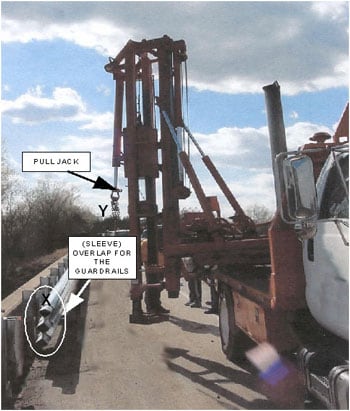
|
| Photo 1. This photo illustrates the truck-mounted post driver used on the day of the incident. An “X” marks the installed section of guardrail. The section of guardrail being lowered was to be slid onto the existing guardrail, like a sleeve. A “Y” marks the pull jack of the post driver. Photograph courtesy of the County Sheriff’s Department. |
On the day of the incident, the crew secured metal posts to the cement railing on the eastbound bridge and installed two 25 foot sections of guardrail without incident. Because the guardrails were too heavy to be placed manually, each guardrail was attached to the pull jack of the truck-mounted post driver by a chain, and then mechanically placed.
At the time of the incident, the crew foreman was operating the truck-mounted post driver from the rear operator station (Photo 2). The truck has the capability of being re-positioned from either inside the cab or from the rear operator station. The post driver/post-puller equipment is mounted on the truck and is operated from the rear operator station. Two Hispanic coworkers had attached the guardrail to the pull jack with a chain and then moved to a position near the front of the truck. Another Hispanic coworker was standing next to the rear of the truck and was helping position the guardrail that was to be slid over a previously installed guardrail, like a sleeve (Photo 1). Two Hispanic workers (the victims) were positioned 25 to 35 feet to the west and behind the truck placing bolts in previously installed guardrail. None of the crew was wearing high-visibility clothing or high visibility head gear.
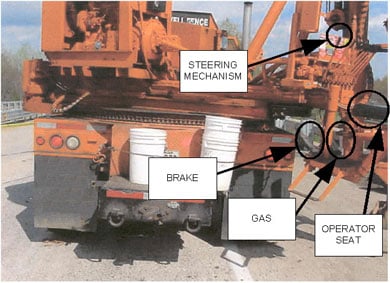
|
| Photo 2. This photo illustrates the rear operator seat and equipment controls. This equipment is operated from a seated position. Photograph courtesy of the NCOSHA. |
The truck-mounted post driver was parked facing east on the right shoulder of the eastbound lanes, parallel and approximately 7 feet from previously installed guardrail posts (Figure). The foreman was lowering the guardrail into place when a coworker who was helping guide his movement of the guardrail section asked him to move the truck back 6 to 8 inches so that he could get the guardrail into position to slide it in place. According to the truck operator’s statement, given to county sheriff’s department investigators, he reached up and pressed the reverse button on the rear control panel, the parking brake lever was down (engaged), and he had his foot on the brake pedal. He reported he did not know what happened next but the truck took off in reverse and he stopped it in the traffic lane before it reached the guardrail on the opposite side of the road. The guardrail flipped in the air but he did not see the guardrail hit the men because he was trying to stop the truck. The truck operator reported to NCOSHA investigators that he had lowered the foot extension on the post driver to help stop the truck’s reverse movement.
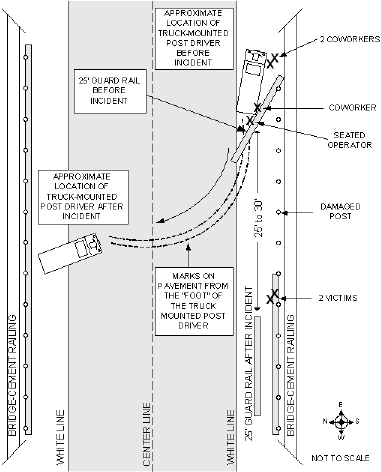 |
| Figure. Adapted from drawing by County Sheriff’s Department of incident scene. |
The coworker who had been helping guide the truck operator reported that the truck brushed against him as it moved backwards, but that he was not injured. Both coworkers standing near the front of the truck told sheriff’s department investigators that they heard the engine “rev” (speed up) and saw the truck jerk backwards. They saw the guardrail flip up in the air and strike the victims. One of these coworkers told NCOSHA investigators that he saw the guardrail hang up briefly on a post and then swing into the victims. The damaged post was located approximately 17 feet from the location of the victims (Photo 3). The open hook that secured the chain around the guardrail unhooked and the guardrail and unbroken chain came to rest in the closed travel lane just a few feet beyond the location of the victims (Photo 4).
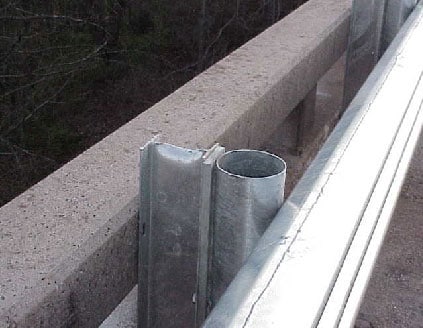
|
| Photo 3. This photo illustrates the damaged post located 17 feet east of victims. |
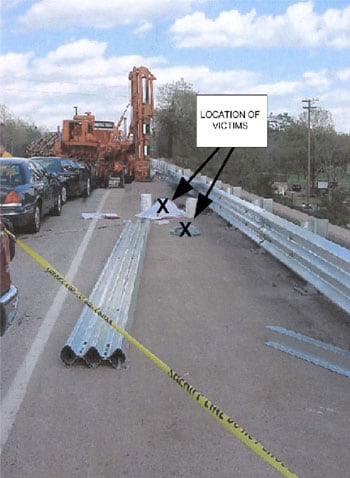 |
| Photo 4. This photo illustrates the location of the victims and the guardrail following the incident. The truck had been driven back to the right shoulder and parked following the incident. Photograph courtesy of the County Sheriff’s Department. |
After the operator stopped the truck, he climbed off the rear operator’s seat and entered the truck’s cab where he used his cell phone to call 911. Due to the extent of the injuries sustained by the victims, no first aid was rendered by coworkers. They dragged the guardrail from the closed travel lane to the closed emergency lane. EMS and police responded within minutes. EMS personnel provided emergency care to the 20-year-old victim who was then transported by medical helicopter to a regional trauma center where he was pronounced dead later that day. The 33-year-old victim was pronounced dead at the scene by the county coroner.
Equipment Information
Company records obtained by NCOSHA indicated that an annual inspection had been performed on the truck on October 1, 2002, at which time no repairs were needed. Maintenance was performed routinely every 3,000 to 5,000 miles and was documented. The truck was not due for maintenance at the time of the incident.
NIOSH investigators met with a representative of the company that manufactured the truck-mounted post driver on June 10, 2003. The truck-mounted post driver, termed a “pounder” by those in the industry, was an aftermarket add-on which was mounted on a heavy duty diesel truck with an automatic transmission. Both truck and the post driver were purchased new in 2001. End users wanting this type of equipment routinely purchase a truck and then send the truck to the manufacturer of the post driver who then installs the post driver onto the truck chassis. The post driver is designed to both drive posts into and pull posts from the ground. The post driver includes a control station at the rear of the truck from which the seated operator can operate the post driver. The operator can also remotely position the truck from the rear control station. The post driver can be combined with both manual and automatic transmission vehicles. Controls to remotely operate the truck are slightly different for each transmission type. (For example, the first lever from the left on the automatic transmission valve bank remotely steers the truck while the first lever on the standard transmission valve bank is used to move and stop the truck). The manufacturer and NIOSH investigators noted that the transmission operator’s manual supplied with the truck contains warnings that the automatic transmission must not be shifted from neutral to drive or reverse when the throttle is open because of the possibility of sudden movement of the vehicle.
According to NCOSHA investigators, the employer had taken the truck to a service center following the incident. A diagnostic check on the truck’s engine was performed and the service center found no malfunction. Because coworkers who witnessed the incident reported hearing the engine rev (speed up) just before it jerked backwards, NCOSHA and the county sheriff’s department investigators hypothesize that the operator may have pressed on the gas pedal as he placed the vehicle in reverse, speeding up the engine and causing the truck to jerk backward.
NIOSH investigators and the manufacturer’s representative reviewed photographs of the truck-mounted post driver taken by the Sheriff’s office after the incident and noted that photographs indicate that the pull jack on the post driver was damaged (Photo 5), corners were sheared off guardrail posts, and the guardrail that was being lowered suffered damage to one end and at the center where the chain had been secured. NIOSH investigators and the manufacturer’s representative believe that evidence and witness statements suggest that the operator pushed the gas pedal instead of the brake by mistake, causing the engine to speed up and the truck to jerk backward. The section of suspended guardrail hung up briefly on a post and then dislodged. The energy released when the guardrail dislodged damaged guardrail posts in its path and caused the suspended guardrail to strike the victims with considerable force.
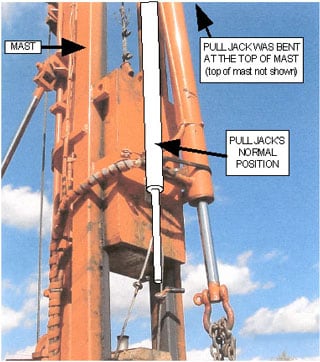
|
| Photo 5. This photo illustrates the pull jack on the post driver which was bent during the incident. It also illustrates how the chain was attached. Photograph courtesy of the County Sheriff’s Department. |
Back to Top
Cause of Death
The death certificate stated that the cause of death for the 33-year-old victim was head trauma with basilar scull fracture and transection of the brain stem. The death certificate stated that the cause of death for the 20-year-old victim was blunt trauma head injury.
Back to Top
Recommendations/Discussion
Recommendation #1: Employers should ensure that equipment operators have been trained in the proper use of equipment they are assigned to operate in accordance with manufacturers’ specifications and recommendations.
Discussion: Employers should train equipment operators in the proper use of equipment and ensure that the equipment manufacturers’ safety recommendations are incorporated into the training. Once completed, the content of the training program and the names of those completing the training should be documented and retained with other company safety records. The operator’s manual for the transmission used on the truck and the operator’s manual for the post driver were not kept on the equipment. The owner had a copy of each at the company’s office. Because these manuals contain lists of manufacturer recommendations for safe operation of the truck and post driver, they should be kept on the equipment at all times. Operator training could have been used to reinforce that the post driver should be used only for pounding and pulling posts, and not for lifting materials such as guardrails, a function for which the post driver was not designed. The truck used during the incident was a newer model and had an automatic push button transmission, older models had manual transmissions. The placement of control levers on the transmission valve bank for each is unique. Training workers using the operator’s manual for the specific piece of equipment assigned, helps workers identify safety recommendations and features unique to the machine in use.
OSHA has developed a standard for performance based training for powered industrial truck operators. Employers are encouraged to use this standard as a model for operator training for other types of equipment, such as truck-mounted post drivers, which are not covered by the standard. The requirements applicable to powered industrial truck operator training are located in 29 CFR 1910.178(1).2
Recommendation# 2: Employers should conduct a job safety analysis (JSA) to determine the appropriate equipment and standard operating procedures that should be followed when moving heavy-duty guardrail sections with mechanized equipment.
Discussion: A job safety analysis (JSA) provides a systematic method for determining the steps that should be taken to perform a job safely.3 The proper equipment for lifting the guardrails and methods used for lifting the load and positioning of workers during the lift can be analyzed during a job safety analysis and safety procedures developed for safe material handling. The JSA would be used to consider and then select the appropriate equipment and methods for lifting and positioning heavy duty guardrails. In this instance, using an appropriately designed moveable hydraulic jack or a truck-mounted crane designed and rigged for this type of task may have been identified as the equipment best suited for lifting and positioning the guardrail. After the JSA has been completed, standard operating procedures (SOPs) should be developed and written and all workers should be trained to follow the SOPs.
Recommendation #3: Employers should develop, implement, and enforce a written comprehensive safety program which includes training in hazard recognition and in the avoidance of unsafe conditions, including, but not limited to, hazards associated with working in proximity of vehicles and equipment.
Discussion: OSHA regulations require employers to train workers to recognize and avoid unsafe conditions that may be present in their work environments and to provide training in regulations applicable to their work (e.g. 29 CFR 1926.21(b)(2)).4 Training should be a vital part of a company’s safety program and should address, at a minimum, all known and anticipated hazards. In this incident, workers may have failed to recognize the hazards present while working in a highway work zone, working in proximity to moving equipment, and working where guardrails were being mechanically positioned. Training should be provided that helps workers recognize hazards in their environment and trains them in the standard operating procedures.
Additional information regarding highway work zone safety measures can be found in a NIOSH publication “Building Safer Highway Work Zones: Measures to Prevent Worker Injuries from Vehicles and Equipment” which is available by calling 1-800-356-4674.5
Recommendation #4: Employers should ensure that workers who are part of a multilingual workforce comprehend instruction in safe work procedures for all tasks to which they are assigned.
Discussion: Companies that employ workers who do not understand English should identify the languages spoken by their employees, and design, implement, and enforce a multi-language safety program. The safety program should be developed at the literacy level that corresponds with the literacy level of the company’s workforce. Companies may need to consider providing special safety training to workers with low literacy to meet their safety responsibilities. The program, in addition to being multi-language, should include a competent interpreter to explain worker rights to protection in the workplace, safe work practices workers are expected to adhere to, specific safety protection for all tasks performed, ways to identify and avoid hazards, and who should be contacted when safety and health issues arise.
Recommendation #5: Employers should develop a policy that requires all employees working in highway work zones to wear high-visibility apparel.
Discussion: High visibility apparel was not worn by workers in this incident and it was not identified by investigators as a contributing factor. However, as a general safety policy, employers should require all employees working in highway work zones to wear company-supplied high visibility apparel. High visibility apparel is defined by ANSI/ISEA as “personal protective safety clothing intended to provide conspicuity during both daytime and nighttime useage.6 High visibility apparel allows workers to be seen more easily and is recommended for workers on foot in highway work zones to help prevent worker injuries.5
Recommendation #6: Manufacturers should clearly identify how equipment is to be used, i.e. the truck-mounted post driver is only to be used for driving and pulling posts and is not intended for other uses, such as hoisting.
Discussion: Manufacturers should consider writing the operator’s manuals to make it clear to the operators what the equipment can and cannot be safely used for. For example, the manufacturer should state that the truck-mounted post driver is not to be used as a hoist. Labeling the machine with information regarding its appropriate uses may also be helpful.
Recommendation #7: Manufacturers should explore the possibility of incorporating emergency stop switches on the rear control panel of the truck-mounted post driver.
Discussion: The manufacturer of the equipment used in this incident is researching the possibility of incorporating an emergency stop “kill switch” on the rear control panel of the truck-mounted post driver. According to the equipment manufacturer’s representative, operators may believe that simply turning the ignition key off from the rear operator station will immediately stop the truck, but this is not how the equipment functions. When the ignition key is turned off, the vehicle will come to a stop when it hits something or rolls to a stop when it loses momentum and reaches level ground.
Additionally, state departments of transportation should consider requiring that contract proposals include a written comprehensive safety program that addresses safe operating procedures and worker training for all tasks to be performed under the contract, and requires that high visibility apparel be worn by all workers on highway construction jobs.
Discussion: To help foster safe work environments for contracted employees, state departments of transportation can level the playing field among all potential contractors by requiring a written safety program in bid specifications. Unless safety is part of the bid specifications, contractors may risk losing jobs when they bid higher to account for costs of training, maintenance, and other safety elements. In bid specifications, agencies can stipulate that all workers on foot be equipped with high-visibility apparel. Additionally, contracting agencies can pre-qualify all contractors and subcontractors to ensure that they have good safety records and can periodically re-evaluate the pre-qualified list of contractors.5
Back to Top
References
- ATSSA [2001]. Manual on uniform traffic control devices (MUTCD), millennium edition, part VI. Fredericksburg, VA: American Traffic Safety Services Association.
- Code of Federal Regulations [2002]. 29 CFR 1910.178(1). Operator Training. U.S. Government Printing Office, Office of the Federal Register, Washington, D.C.
- National Safety Council (1997). Accident Prevention Manual for Business and Industry. Administration and Programs. Eleventh Edition, Itasca, Illinois.
- Code of Federal Regulations [2002]. 29 CFR 1926.21 (b) (2). Safety Training and Education. U.S. Government Printing Office, Office of the Federal Register, Washington, D.C
- NIOSH [2001]. Building safer highway work zones: measures to prevent worker injuries from vehicles and equipment. U.S. Department of Heath and Human Services, Public Health Service, Centers for Disease Control and Prevention, National Institute for Occupational Safety and Health, DHHS (NIOSH) Publication No. 2001-128.
- ANSI/ISEA [1999]. American National Standard for high-visibility safety apparel. New York, NY: American National Standards Institute, ANSI/ISEA 107-1999.
Back to Top
Investigator Information
This investigation was conducted by Doloris N. Higgins and Nancy Romano, Safety and Occupational Health Specialists, Fatality Assessment and Control Evaluation Team, Surveillance and Field Investigations Branch, Division of Safety Research. Engineering assistance was provided by Tim Merinar, Safety Engineer, Surveillance and Field Investigations Branch, Division of Safety Research.
